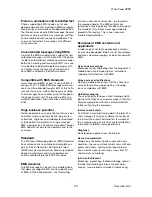
White Paper
J200
16
November 2004
General Packet Radio Services
The introduction of GPRS (General Packet Radio
Services) is one of the key steps in the evolution of
today’s GSM networks for enhancing the capabili-
ties of data communication. Data traffic is increas-
ing enormously (over both wired and wireless
networks), with the growth in demand for Internet
access and services paralleling that for mobile
communications.
The demand for high-speed Internet access will be
the key driver for coming generations of wireless
services, and GPRS can deliver the necessary
speed. GPRS allows creation of innovative serv-
ices, makes it possible to address new and previ-
ously inaccessible market segments and increases
customer loyalty.
GPRS applications can be developed as both hori-
zontal and vertical. Vertical applications are spe-
cific, including those for operations such as
reaching police and emergency, taxi, delivery or
automated services (vending machines, supervi-
sion, vehicle tracking). Horizontal applications are
more generic and include those for Internet access,
e-mail, messaging, e-commerce and entertain-
ment.
GPRS is able to take advantage of the global cov-
erage of existing GSM networks. Applications
developed for GPRS can be deployed on a large
scale and can reap the associated benefits. GPRS
also provides a secure medium for connections to
banking and financial services.
Using GPRS in the J200
Instead of occupying an entire voice channel for
the duration of a data session, the J200 sends/
receives data in small packets, as needed, much
like IP on the Internet. Because of this, the J200
maintains a constant online connection, its data
transmission abilities summoned by the application
in use on an as-needed basis.
The GPRS specification includes four coding
schemes – CS1, CS2, CS3 and CS4 – that allow
data speeds of 9,050 bps, 13,400 bps, 15,600 bps
and max 21,400 bps per slot, respectively. The
J200 works with all four coding schemes, but data
speed naturally varies according to network config-
uration. At the moment, CS-3 and CS-4 are not
supported in any live network, i.e, present speed is
limited to 53,600 bps.
The GSM system limits the ability to use all eight
time slots, so the J200 uses up to four time slots
for receiving data, and one slot for transmitting.
This means the speed for receiving data is up to
85,600 bps and up to 21,400 bps for sending data.
Using GPRS with the J200 has several advantages,
for example:
•
Constant connection
•
High speed
•
Automatic access to increased bandwidth while
downloading large files such as pictures and
sounds
•
Cost efficiency
•
Use of transmission capacity only when needed
to reduce cost
•
WAP over GPRS
•
Access to Internet via WAP at high speed and
with a constant connection.
•
Provide settings
•
Receive GPRS configuration settings from the
provider over the air, OTA, making manual con-
figuration unnecessary.
•
User controlled settings
•
Take advantage of full user control in the data
connections menu, establishing multiple
descriptions and accessing advanced settings
for GPRS.
Interruption of GPRS data account
When the user is using WAP via GPRS on the J200,
the GPRS connection is automatically discon-
nected when the user answers an incoming call.
However, when the call has ended, the user is
given the possibility to resume the WAP session.
Содержание J200
Страница 1: ...November 2004 J200 ...
Страница 11: ...White Paper J200 11 November 2004 Technologies in detail ...
Страница 26: ...White Paper J200 26 November 2004 Facts and figures ...
















































